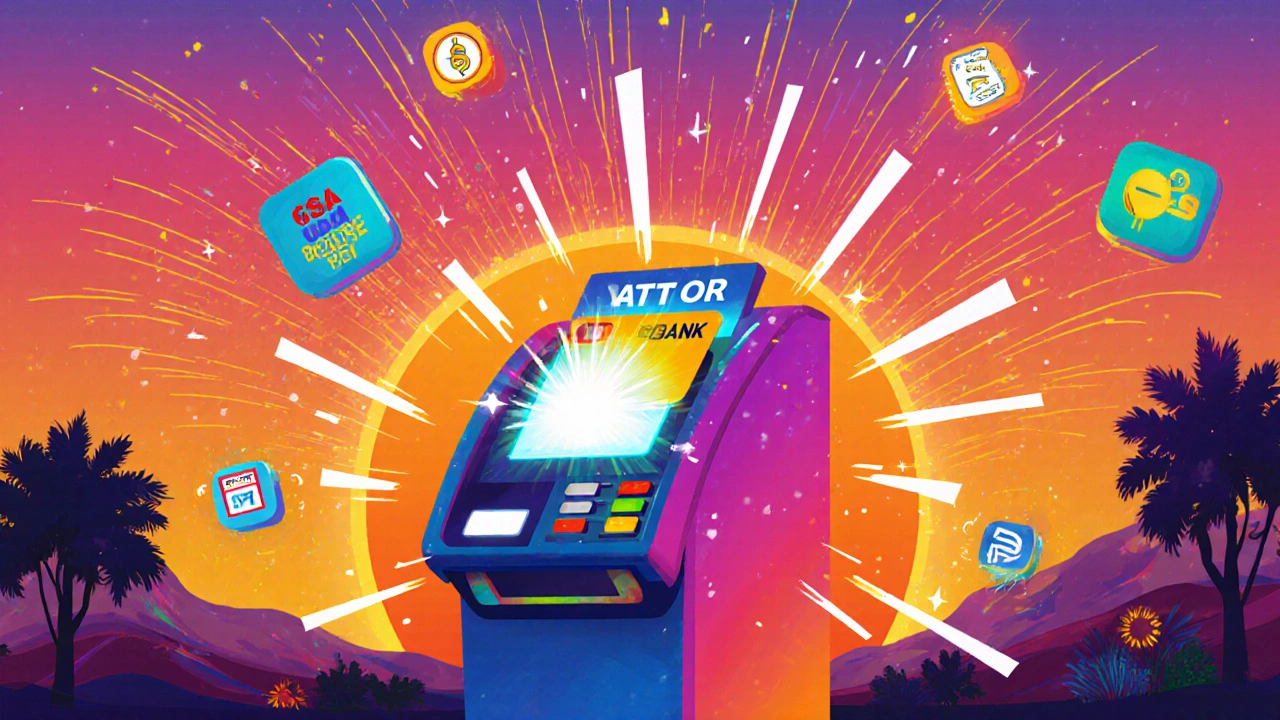EDA Cost Calculator
Calculate your potential savings from implementing event-driven architecture. Based on real financial industry data from the article.
Estimated Monthly Cost
AWS EventBridge
Apache Kafka
Confluent Cloud
Savings Analysis
Based on industry data from the article, banks using EDA cut annual infrastructure costs by $1.2 million on average.
Annual Savings
ROI Timeline
Key Insights
Idempotency note: The article mentions that top banks reduce duplicate transactions to less than 0.001% by implementing unique event IDs. This is critical for financial systems where duplicate transactions would be disastrous.
Most banks still process transactions in batches. You make a purchase at 11:47 PM, and it doesn’t show up in your account until morning. That’s not a glitch - it’s the old way. But behind the scenes, the biggest banks are quietly switching to something faster, smarter, and more reliable: event-driven architecture.
What Event-Driven Architecture Actually Does in Finance
Event-driven architecture (EDA) isn’t about fancy buzzwords. It’s about reacting instantly to what happens. When you swipe your card, that action isn’t just sent to a server to wait in line. It becomes an event - a signal that something changed. That event gets picked up by other systems immediately: fraud detection checks it, your balance updates, the merchant gets paid, and the settlement process starts - all in under a second. This isn’t theory. In 2023, top U.S. banks using EDA processed 99.8% of debit and credit card transactions in under 200 milliseconds. Compare that to legacy systems, which took half a second or more per transaction - and often had to wait until end-of-day to settle. EDA doesn’t just speed things up. It changes how money moves.How Streams and Pub/Sub Work Together
Think of EDA like a radio station. One system (like your bank’s payment app) broadcasts an event: “User X spent $89.99 at Amazon.” That’s the event producer. The broadcast channel? That’s the event broker - usually Apache Kafka, AWS EventBridge, or Confluent Cloud. These brokers don’t store messages forever. They hold them briefly and push them out to anyone who’s listening. The listeners? Those are the event consumers. Fraud detection listens. Balance updates listen. Tax reporting listens. Compliance checks listen. Each system only cares about the events that matter to it. No one has to ask for updates. Everything happens automatically. This is pub/sub - publish and subscribe. It’s clean, scalable, and flexible. If you add a new fraud model next month, you just plug it in. You don’t rewrite the payment system. That’s why banks like Capital One now handle 2.1 billion events daily across 15 different services without breaking a sweat.Why This Matters More Than You Think
Real-time isn’t just about convenience. It’s about survival. The Federal Reserve launched FedNow in July 2023 - a national instant payment network. If your bank can’t handle events in real time, you’re already behind. Same with Europe’s PSD2 rules, which force banks to give third-party apps instant access to account data. No EDA? No compliance. Fraud detection is where EDA shines brightest. Traditional systems check transactions after they happen. EDA checks them as they happen. One major U.S. bank reduced false fraud alerts by 37% and caught 83% more fraud within seconds instead of hours. That’s not just money saved - it’s trust kept. Loan approvals used to take days. Now, with EDA, a borrower submits an application, income is verified in real time, credit score is pulled, risk is calculated, and approval is sent - all in under five minutes. That’s not magic. That’s event streams connecting systems that used to sit in silos.
The Tools Banks Actually Use
Not all event systems are the same. Here’s what’s actually running in production:- AWS EventBridge: Used by mid-sized banks for its simplicity. It’s serverless, so you don’t manage servers. Handles up to 5,000 requests per second per account. Costs about $0.04 per 1,000 events.
- Apache Kafka: Used by big banks like JPMorgan. Can handle 10,000+ messages per second per node. But it needs a team of engineers to keep it running. Not for beginners.
- Confluent Cloud: A managed version of Kafka. Popular with banks that want Kafka’s power without the headaches.
- Temporal: Not a messaging system - it’s a workflow engine. Used for complex processes like loan underwriting or multi-step payments. Keeps track of what happened, even if a system crashes. Cuts failure rates from 7% down to 0.3%.
The Hidden Problems Nobody Talks About
It’s not all smooth sailing. Sixty-eight percent of banks say they struggled to keep data consistent across services during the first year. Imagine a payment goes through, but the balance doesn’t update. Or fraud flags it, but the system still approves it. That’s chaos. The fix? Idempotency. Every event must have a unique ID. If the same event comes in twice - maybe because of a network hiccup - the system knows to ignore the duplicate. Top banks reduce duplicates to less than 0.001%. That’s not easy. It takes careful code, testing, and monitoring. Another issue? Debugging. When a transaction fails across 10 services, where did it break? Traditional systems had a clear path. EDA? It’s like tracing a phone call that bounced through 10 different operators. That’s why workflow tools like Temporal are becoming essential. They give you a map of every step - even if a system went offline for 10 minutes.
Costs, ROI, and Real Numbers
Yes, EDA costs money. But it saves more. Banks using EDA cut annual infrastructure costs by $1.2 million on average. Why? No more overnight batch servers. No more weekend maintenance windows. No more paying for idle capacity. AWS reports that EventBridge cuts operational costs by 45% compared to self-hosted Kafka for institutions processing 100 million events a month. That’s a huge win for regional banks that can’t afford a 10-person ops team. ROI timelines? Most banks see returns within 18 months. Gartner says 62% of institutions report positive ROI. But 45% say implementation took longer than expected - often because teams underestimated the complexity of event schema design and versioning.How to Start Without Overwhelming Your Team
You don’t need to rebuild everything tomorrow. Start small.- Find one high-value, high-volume process: fraud detection, card authorization, or real-time balance updates.
- Pick one tool: EventBridge for simplicity, Kafka if you have the team.
- Build a single event: “Payment Approved.” Make it idempotent. Add logging.
- Connect one consumer: maybe a notification system.
- Measure: latency, error rate, cost.
- Then add another. And another.
The Future Is Already Here
By 2025, Gartner predicts 80% of new financial core systems will be built on event-driven patterns. That’s up from 25% in 2022. The market for EDA in finance is projected to hit $12.7 billion by 2027. Why? Because customers expect instant results. Regulators demand real-time reporting. Competitors are already moving. The banks clinging to batch processing won’t disappear overnight - but they’ll keep losing ground. The real winners? Those who treat events not as technical details, but as the heartbeat of their financial system. Because in finance, time isn’t just money. It’s trust.What’s the difference between event-driven architecture and traditional banking systems?
Traditional banking systems use request-response - one system asks another for data, waits for a reply, and moves on. This creates bottlenecks and delays. Event-driven architecture uses streams and pub/sub: systems broadcast changes (events), and others listen and react instantly. This cuts settlement times from hours to seconds and allows systems to work independently without waiting on each other.
Do I need Kafka to use event-driven architecture in finance?
No. Kafka is powerful and handles high volume, but it’s complex and needs a dedicated team. Many banks, especially mid-sized ones, use AWS EventBridge or Confluent Cloud - managed services that handle scaling and maintenance for you. You only need Kafka if you’re processing over 10,000 events per second and have the engineering resources to support it.
How do banks handle duplicate events in real-time systems?
Every event must include a unique ID. Systems check this ID before processing. If the same ID appears again, the system ignores it. This is called idempotency. Top banks reduce duplicate transactions to less than 0.001% by combining unique IDs with deduplication functions in their event brokers. Without this, double payments or fraud alerts could multiply.
Is event-driven architecture secure for financial data?
Yes, if designed correctly. Events are encrypted in transit and at rest. Access is controlled through strict IAM policies and service-to-service authentication. Most banks also use private networks and audit logs for every event. The bigger risk isn’t security - it’s misconfiguration. A poorly set-up event bus can expose data. That’s why most institutions start with managed cloud services like EventBridge, which handle security by default.
Can small banks or credit unions use event-driven architecture?
Absolutely. You don’t need to be a giant bank. AWS EventBridge and Confluent Cloud let small institutions start with just a few events - like real-time fraud alerts or balance updates. Many regional banks begin with one use case, like instant payment notifications, and scale from there. The cost is as low as $0.04 per 1,000 events. For most small banks, the ROI comes within a year.
What’s the biggest mistake banks make when adopting EDA?
Trying to replace everything at once. EDA isn’t a full-system rewrite - it’s an evolution. The biggest failures happen when teams skip event versioning, don’t test idempotency, or ignore monitoring. Successful banks start small, document every event, and build incrementally. They treat EDA like a muscle - you strengthen it over time, not with one heavy lift.

RAHUL KUSHWAHA
November 16, 2025 AT 02:23Julia Czinna
November 16, 2025 AT 13:26Laura W
November 16, 2025 AT 22:42Graeme C
November 17, 2025 AT 08:30